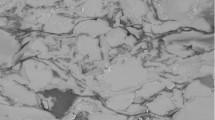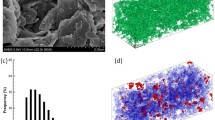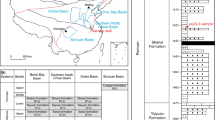Abstract
Inorganic pore structures are critical to understand the oil and gas transport and storage properties of unconventional reservoirs. However, it can be difficult to quantitatively and qualitatively interpret the relationship between the inorganic pore structure and particle arrangement in terms of particle size and the brittle and clay mineral composition of shale. In this paper, artificial core simulations and mathematical modeling were performed to explore the effects of brittle mineral and clay mineral assemblages on shale pore structures. The artificial cores were subjected to computerized tomography and scanning electron microscopy analysis, as well as porosity and permeability testing. The results show that shale porosity and permeability increase with the brittle to clay mineral particle size ratio. This phenomenon is caused by the different arrangements of inorganic minerals in shale when the brittle to clay mineral particle size ratio is < 1 and > 1. A theoretical mathematical model based on mineral arrangement shows that shale permeability can be characterized by the inverse proportional function of mineral particle size. This investigation of shale pore heterogeneities on meso- and macroscales based on artificial cores provides new insights into the simulation of oil and gas transport in micro- to nanoscale pores and the understanding of pore evolution during the first diagenesis stage of shale, which is mainly composed of inorganic minerals.









Similar content being viewed by others
References
Ai-Homadhi ES (2002) Artificial sandstone cores production with a wide range of petrophysical properties. King Saud Univ 14:95–118. https://doi.org/10.1016/S1018-3639(18)30747-5
Bahrekazemi S, Hekmatzadeh M (2017) Neuro-simulation tool for enhanced oil recovery screening and reservoir performance prediction. Ital J Sci Eng 1(2):54–64. https://doi.org/10.28991/esj-2017-01116
Buiting JJM, Clerke EA (2013) Permeability from porosity measurements: derivation for a tortuous and fractal tubular bundle. J Petrol Sci Eng 108:267–278. https://doi.org/10.1016/j.petrol.2013.04.016
Caicedo B, Ocampo M, Vallejo L (2016) Modelling comminution of granular materials using a linear packing model and Markovian processes. Comput Geotech 80(August):383–396. https://doi.org/10.1016/j.compgeo.2016.01.022
Capowiez Y, Monestiez P, Belzunces L (2001) Burrow systems made by Aporrectodea nocturna, and Allolobophora chlorotica, in artificial cores: morphological differences and effects of interspecific interactions. Appl Soil Ecol 16(2):109–120. https://doi.org/10.1016/S0929-1393(00)00110-4
Dong JJ, Wu WJ (2012) Estimating the permeability-depth relation of sedimentary rocks based on the porosity-permeability relation and porosity well logging. In: EGU general assembly conference. EGU general assembly conference abstracts
Elsharafi MO, Bai BJ (2016) Effect of back pressure on the gel pack permeability in mature reservoir. Fuel 183(1):449–456. https://doi.org/10.1016/j.fuel.2016.06.103
Epstein N (1989) On tortuosity and the tortuosity factor in flow and diffusion through porous media. Chem Eng Sci 44(3):777–779. https://doi.org/10.1016/0009-2509(89)85053-5
Fauchille AL, Eijnden AP van den, Ma L, Chandler M, Taylor KG, Madi K, Lee PD (2018) Variability in spatial distribution of mineral phases in the Lower Bowland Shale, UK, from the mm- to μm-scale: quantitative characterization and modelling. Mar Petrol Geol 92:109–127. https://doi.org/10.1016/j.marpetgeo.2018.02.029
Hartkamp CA, Arribas J, Tortosa A (2010) Grain size, composition, porosity and permeability contrasts within cross-bedded sandstones in tertiary fluvial deposits, central Spain. Sedimentology 40(4):787–799. https://doi.org/10.1111/j.1365-3091.1993.tb01360.x
Ji WM, Song Y, Jiang ZX, Chen L, Wang PF, Liu QX, Gao FL, Yang X (2016) Micro-nano pore structure characteristics and its control factors of shale in Longmaxi Formation, southeastern Sichuan Basin. Acta Petrolei Sin 37(2):182–194. https://doi.org/10.7623/syxb201602004 (in Chinese with English Abstract)
Kwon O, Herbert BE, Kronenberg AK (2004) Permeability of illite-bearing shale: 2. Influence of fluid chemistry on flow and functionally connected pores. J Geophys Res Atmos 109(10):67–85. https://doi.org/10.1029/2004JB003055
Lei G, Dong PC, Yang S (2014) Study of stress-sensitivity of low-permeability reservoir based on arrangement of particles. Rock Soil Mech 35(1):209–214 (in Chinese with English Abstract)
Li Y, Wang X, Wu B, Li G, Wang D (2016a) Sedimentary facies of marine shale gas formations in southern china: the lower silurian longmaxi formation in the Southern Sichuan Basin. J Earth Sci 27(5):807–822. https://doi.org/10.1007/s12583-015-0592-1
Li J, Zhou S, Li Y, Ma Y, Yang Y, Li C (2016b) Effect of organic matter on pore structure of mature lacustrine organic-rich shale: a case study of the Triassic Yanchang shale, Ordos basin, China. Fuel 185(1):421–431. https://doi.org/10.1016/j.fuel.2016.07.100
Lin F (2018) Construction network ventilation system for underground LPG storage cavern. Civ Eng J 4(7):1521–1541. https://doi.org/10.28991/cej-0309192
Liu XH (2015) Petrological characteristics of shale and its influence on adsorbed gas volume. Southwest Petroleum University, Chengdu (in Chinese with English Abstract)
Lv W-F, Qin J-S, Wu K-Y, Liu Q-J, Yan S-G (2011) An overview of testing methods of poroperm and relative permeability for low permeability rocks. Spec Oil Gas Reserv 18(3):1–6 (in Chinese with English Abstract)
Martin RT (1965) Research in earth physics—phase report no. 4. Quantitative fabric of consolidated kaolinite. Diffraction, Paris
Nematollahi H, Moradi N, RiyaziNejad M, Vahidi H (2018) Removal of aliphatic hydrocarbons from gas oil contaminated clay soil via soil vapor extraction. Civ Eng J 4(8):1858–1868. https://doi.org/10.28991/cej-03091120
Schieber J (2010) Common themes in the formation and preservation of intrinsic porosity in shales and mudstones—illustrated with examples across the Phanerozoic. SPE-132370. https://doi.org/10.2118/132370-MS
Schneider J, Flemings PB, Daystirrat RJ (2011) Insights into pore-scale controls on mudstone permeability through resedimentation experiments. Geology 39(11):1011–1014. https://doi.org/10.1130/G32475.1
Slatt RM, O’Brien NR (2011) Pore types in the Barnett and Woodford gas shales: contribution to understanding gas storage and migration pathways in fine-grained rocks. AAPG Bull 95(12):2017–2030. https://doi.org/10.1306/03301110145
Subero J, Ghadiri M, Thornton C (1999) Effect of interface energy on the impact strength of agglomerates. Power Technol 105(1–3):66–74. https://doi.org/10.1016/S0032-5910(99)00119-9
Sun M, Yu B, Hu Q, Yanga R, Zhang Y, Li B, Melnichenkod YB, Cheng G (2018) Pore structure characterization of organic-rich Niutitang shale from China: small angle neutron scattering (SANS) study. Int J Coal Geol 186(1):115–125. https://doi.org/10.1016/j.coal.2017.12.006
Taylor HF, O’Sullivan C, Shire T, Moinet WW (2019) Influence of the coefficient of uniformity on the size and frequency of constrictions in sand filters. Géotechnique 69(3):274–282. https://doi.org/10.1680/jgeot.17.T.051
Vallejo LE, Mawby R (2000) Porosity influence on the shear strength of granular material–clay mixtures. Eng Geol 58(2):125–136. https://doi.org/10.1016/S0013-7952(00)00051-X
Wang Y, Li X, Zheng B, Zhang YX, Li GF, Wu YF (2016) Experimental study on the non-Darcy flow characteristics of soil–rock mixture. Environ Earth Sci 75(9):1–18. https://doi.org/10.1007/s12665-015-5218-5
Wang R, Haikuan N, Hu Z, Liu G, Xi B, Liu W (2020) Controlling effect of pressure evolution on shale gas reservoirs: a case study of the Wufeng-Longmaxi Formation in the Sichuan Basin. Nat Gas Ind 40(10):1–11. https://doi.org/10.3787/j.issn.1000-0976.2020.10.001 (in Chinese with English Abstract)
Wang R, Sang S, Zhu D, Liu S, Yu K (2017) Pore characteristics and controlling factors of the Lower Cambrian Hetang Formation shale in Northeast Jiangxi, China. Energy Explor Exploit 36(11):1–23. https://doi.org/10.1177/0144598717723814
Wang P, Wu LL, Geng AS, Fang YX (2018) Influence of compositions and pore structure on sealing capacity of Wufeng-Longmaxi Formation shale from southeast Sicuan Basin. Geochimica 47(6):661–674. https://doi.org/10.19700/j.0379-1726.2018.06.007 (in Chinese with English Abstract)
Wang H, Liu Y, Song Y, Zhao Y, Zhao J (2012) Fractal dimension analysis on pore structure of artificial cores using magnetic resonance imaging. In: International conference on consumer electronics, communications and networks (CECNet), vol 2, pp 2593–2596. https://doi.org/10.1109/CECNet.2012.6202182
Wałowski G (2018) Experimental assessment of porous material anisotropy and its effect on gas permeability. Civ Eng J 4(4):906–915. https://doi.org/10.28991/cej-0309143
Xue H, Wang H, Liu H, Yan G, Guo W, Li X (2013) Adsorption capability and aperture distribution characteristics of shales: taking the Longmaxi Formation shale of Sichuan Basin as an example. Acta Petrol Sin 34(5):826–832. https://doi.org/10.7623/syxb201305003 (in Chinese with English Abstract)
Yang HL, Shen RC, Fu L (2013) Composition and mechanical properties of gas shale. Petrol Drill Tech 41(5):31–38. https://doi.org/10.3969/j.issn.1001-0890.2013.05.006 (in Chinese with English Abstract)
Zalc JM, Reyes SC, Iglesia E (2004) The effects of diffusion mechanism and void structure on transport rates and tortuosity factors in complex porous structures. Chem Eng Sci 59(14):2947–2960. https://doi.org/10.1016/j.ces.2004.04.028
Zhao XY, Zhang YY (1990) Clay minerals and clay mineral analysis. China Ocean Press, Beijing, pp 27–28 (in Chinese)
Zhou XQ (2013) Research on the effect of friction coefficient on particle packing density. Dissertation, South China University of Technology (in Chinese with English Abstract)
Zhua HJ, Ju YW, Qi Y, Huang C, Zhang L (2018) Impact of tectonism on pore type and pore structure evolution in organic-rich shale: implications for gas storage and migration pathways in naturally deformed rocks. Fuel 228:272–289. https://doi.org/10.1016/j.fuel.2018.04.137
Acknowledgements
This work has been supported by Natural Science Foundation of China (grant no. 41872250). The authors are also very grateful to anonymous reviewers for their very constructive and helpful comments on the final manuscript. The laboratory studies in this paper were done at the China University of Geosciences (Wuhan), and we received help from the Key Lab of Carbonate Reservoirs, CNPC, Hangzhou, China.
Author information
Authors and Affiliations
Corresponding author
List of Symbols
List of Symbols
- Φ :
-
Theoretical porosity of an artificial core
- V :
-
Theoretical volume of an artificial core
- r core :
-
Radius of an artificial core
- h :
-
Height of an artificial core
- V NaCl :
-
Theoretical volume of NaCl
- V Q :
-
Theoretical volume of quartz
- V S :
-
Theoretical volume of smectite
- a Q :
-
Mass percentages of quartz
- a S :
-
Mass percentages of smectite
- C u :
-
Coefficient of uniformity, Cu = D60/D10, D60 = size of the particle corresponding to 60% finer and, D10 = size of the particle corresponding to 10% finer
- D B :
-
Brittle mineral side length
- D C :
-
Clay mineral length
- d :
-
Height of each clay mineral
- L :
-
Cubic shale sample side length
- L T :
-
Actual length of the connected pores
- m B :
-
Mass of the brittle minerals
- n B :
-
Number of brittle minerals in shale
- ρ B :
-
Density of the brittle minerals
- m C :
-
Mass of the clay minerals
- ρ C :
-
Density of the clay minerals
- m S :
-
Mass of the shale
- ω B :
-
Mass ratio of the brittle minerals in the shale
- N B :
-
Number of the brittle minerals in the vertical or longitudinal direction
- N C :
-
Number of clay minerals in the longitudinal direction
- k :
-
Permeability
- r :
-
Diameter of the connected pores
- A :
-
Shale cross-sectional area
- n :
-
Number of connected pores
Rights and permissions
About this article
Cite this article
Zhou, W.D., Xie, S.Y., Bao, Z.Y. et al. Modeling of the Correlation Between Mineral Size and Shale Pore Structure at Meso- and Macroscales. Math Geosci 54, 131–150 (2022). https://doi.org/10.1007/s11004-021-09954-w
Received:
Accepted:
Published:
Issue Date:
DOI: https://doi.org/10.1007/s11004-021-09954-w




